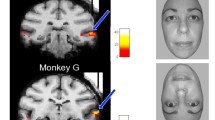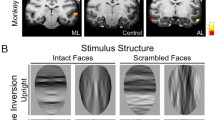Summary
There is a population of neurons in the cortex in the middle and anterior part of the superior temporal sulcus (STS) of the monkey with responses which are selective for faces. To investigate whether the responses of these neurons show some of the perceptual properties of face recognition such as tolerance to changes in the size and contrast of the face, the effects of alteration of the size and contrast of an effective face stimulus on the responses of these neurons were analysed quantitatively in macaque monkeys. First, it was shown that the majority of these neurons had responses which were relatively invariant with respect to the size of the stimulus. The median size change tolerated with a response of greater than half the maximal response was 12 times. Second, it was found that for a few of these neurons, the size of the face did affect the neuronal response. For most of these neurons, it was found that when the size of the image and its distance were altered, the neuronal response was related to the retinal angle subtended by the image. But for four neurons the absolute size of the image determined the magnitude of the neuronal response, independently of the distance of the image. Thus these four neurons showed size constancy. It is suggested that these neurons would be useful as part of a face recognition system, because only objects in a certain absolute size range should normally be classified as faces. Third, the responses of the neurons were relatively invariant with respect to the contrast of the face. The mean contrast at which the neurons still responded with more than half the maximal response was 0.26. Fourth, the responses of the neurons were relatively invariant with respect to the sign of the contrast of the face, that is the neurons responded to negative as well as to positive images of faces. Fifth, the neurons typically responded to a face when the information in it had been reduced from 3D to a 2D representation in gray on a monitor, with a response which was on average 0.5 that to a real face. These results show that the responses of these neurons have some of the invariant properties with respect to size and contrast alteration shown by face perception, and show that their processing is at a level which would be useful in face recognition. The results also show that the responses of these neurons are not simply to local contour information.
Similar content being viewed by others
References
Aggleton JP, Passingham RE (1981) Stereotaxic surgery under X- ray guidance in the rhesus monkey, with special reference to the amygdala. Exp Brain Res 44: 271–276
Baylis GC, Rolls ET (1986) Responses of neurons in the inferior temporal visual cortex in short term and serial recognition memory tasks. Exp Brain Res (in press)
Baylis GC, Rolls ET, Leonard CM (1985) Selectivity between faces in the responses of a population of neurons in the cortex in the superior temporal sulcus. Brain Res 342: 91–102
Baylis GC, Rolls ET, Leonard CM (1986) Functional subdivisions of temporal lobe neocortex. J Neurosci (in press)
Brace C, Desimone R, Gross CG (1981) Visual properties of neurons in a polysensory area in superior temporal sulcus of the macaque. J Neurophysiol 46: 369–384
Bruning JL, Kintz BL (1977) Computational handbook of statistics, 2nd edn. Scott Foresman, Glenview Ill
Davies G, Ellis H, Shepherd J (eds) (1981) Perceiving and remembering faces. Academic Press, London
Dember WN, Warm JS (1979) Psychology of perception, 2nd edn. Holt Rinehart and Winston, New York
Desimone R, Albright TD, Gross CG, Bruce C (1984) Stimulusselective responses of inferior temporal neurons in the macaque. J Neurosci 4: 2051–2062
DeValois RL, Albrecht DG, Thoreil LG (1982) Spatial frequency selectivity of cells in macaque visual cortex. Vision Res 22: 545–559
Galper RE (1970) Recognition of faces in photographic negative. Psychon Sci 19: 207–208
Gross CG, Rocha-Miranda CE, Bender DB (1972) Visual properties of neurons in inferotemporal cortex of the macaque. J Neurophysiol 35: 96–111
Humphrey NK, Weiskrantz L (1969) Size constancy in monkeys with inferotemporal lesions. QJ Exp Psychol 21: 225–238
Kulikowski JJ, Bishop PO (1981) Linear analysis of the responses of simple cells in the cat visual cortex. Exp Brain Res 44: 386–400
Merrill EG, Ainsworth A (1972) Glass-coated platinum-plated tungsten microelectrodes. Med Biol Eng 10: 662–672
Perrett DI, Rolls ET, Caan W (1982) Visual neurons responsive to faces in the monkey temporal cortex. Exp Brain Res 47: 329–342
Rolls ET (1981a) Responses of amygdaloid neurons in the primate. In: Ben-Ari Y (ed) The amygdaloid complex. Elsevier, Amsterdam, pp 383–393
Rolls ET (1981b) Processing beyond the inferior temporal visual cortex related to feeding, memory, and striatal function. In: Katsuki Y, Norgren R, Sato M (eds) Brain mechanisms of sensation, Chap 16. Wiley, New York, pp 241–269
Rolls ET (1984) Neurons in the cortex of the temporal lobe and in the amygdala of the monkey with responses selective for faces. Hum Neurobiol 3: 209–222
Rolls ET (1986) Information representation, processing and storage in the brain: analysis at the single neuron level. In: Changeux JP, Konishi M (eds) Neural and molecular mechanisms of learning. Springer, Berlin
Rolls ET, Burton MJ, Mora F (1976) Hypothalamic neuronal responses associated with the sight of food. Brain Res 111: 53–66
Rolls ET, Sanghera MK, Roper-Hall A (1979) The latency of activation of neurones in the lateral hypothalamus and substantia innominata during feeding in the monkey. Brain Res 164: 121–135
Rolls ET, Perrett DI, Caan AW, Wilson FAW (1982) Neuronal responses related to visual recognition. Brain 105: 611–646
Rolls ET, Baylis GC, Leonard CM (1985) Role of low and high spatial frequencies in the face-selective responses of neurons in the cortex in the superior temporal sulcus in the monkey. Vision Res 25: 1021–1035
Saxton WO, Koch TL (1982) Interactive image processing with an off-line minicomputer: organization, performance and applications. J Microsc 127: 69–83
Schwartz EL, Desimone R, Albright TD, Gross CG (1983) Shape recognition and inferior temporal neurons. Proc Natl Acad Sci 80: 5776–5778
Seltzer B, Pandya DN (1978) Afferent cortical connections and architectonics of the superior temporal sulcus and surrounding cortex in the rhesus monkey. Brain Res 149: 1–24
Tolhurst DJ, Movshon JA, Thompson ID (1981) The dependence of response amplitude and variance of cat visual cortical neurones on stimulus contrast. Exp Brain Res 41: 414–419
Ungerleider LG, Ganz L, Pribram KH (1977) Size constancy in rhesus monkeys: effects of pulvinar, prestriate, and inferotemporal lesions. Exp Brain Res 27: 251–269
Weiskrantz L, Saunders RC (1984) Impairments of visual object transforms in monkeys. Brain 107: 1033–1072
Author information
Authors and Affiliations
Rights and permissions
About this article
Cite this article
Rolls, E.T., Baylis, G.C. Size and contrast have only small effects on the responses to faces of neurons in the cortex of the superior temporal sulcus of the monkey. Exp Brain Res 65, 38–48 (1986). https://doi.org/10.1007/BF00243828
Received:
Accepted:
Issue Date:
DOI: https://doi.org/10.1007/BF00243828




